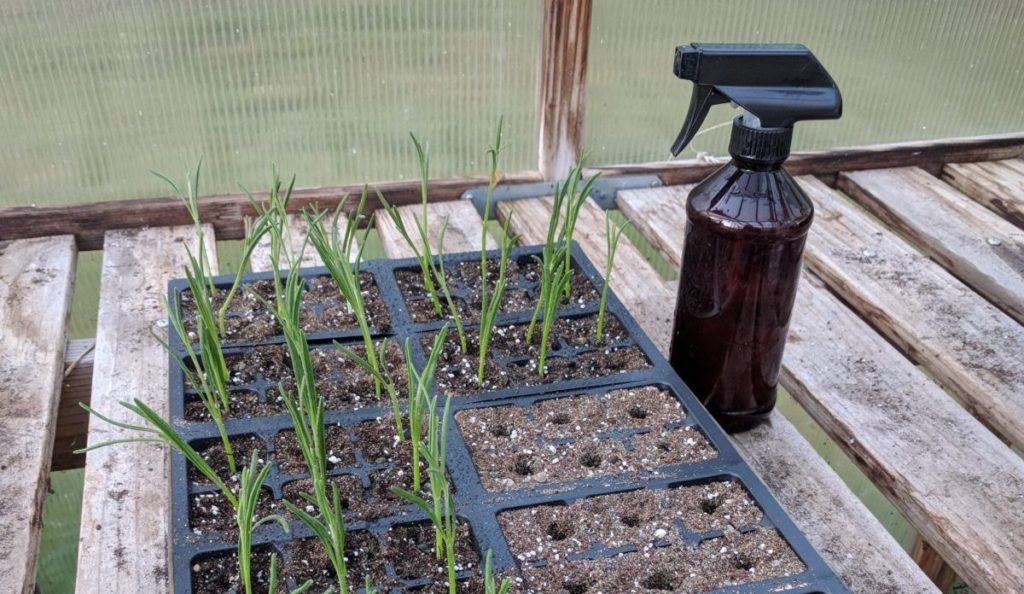One of my most favorite successes as a lavender farmer last year was the propagation of 500 lavender starts to plant in our new field. I took photos throughout the process to share with you, but wanted to wait until this spring to walk you through it because now is when you should start thinking about whether you have any lavender plants you’d like to propagate.
Propagation refers to the creation of a new plant from an existing plant.
What is propagation?
At its simplest, propagation is the term for creating a new plant. Asexual propagation through cuttings (cloning), which is what this blog is focused on, uses a cutting from an existing plant and grows a new plant from the cutting. This is an ancient form of gardening/farming; the Bartlett pear is an example of a common plant that has been asexually propagated through cloning for over two centuries.
Lavender propagation through cutting involves taking a cutting of a stem and planting it as a seedling. Once it roots, the new stem is treated just like any other lavender start that would be grown from seed. This manual from the University of Maine is a more in-depth look at all the ways plants can be propagated.

Propagation refers to the creation of a new plant from an existing plant.
Why does a lavender farmer propagate?
Most lavandulas, including the species angustifolia, dentata, and stoechas, you can grow from seeds. However, lavandula intermedia is a sterile hybrid, and does not produce seed. The intermedia lavender plant starts you see at nurseries have been cloned from their original parents; there is no way to grow a “true” lavandula intermedia variety from seed.
That being said, all lavender can be propagated by cutting (not just intermedia.) So why would a lavender farmer choose to clone rather than grow something from seed? There are three primary reasons: cost, ease, and control.
- Cost: As long as the variety is not patented,* farmers can propagate their current stock to create hundreds of new plants at a fraction of the cost of buying starts.
- Ease: While seed is not cost prohibitive, it takes longer to develop a new plant from seed than it does from a cutting.
- Control: We have personally experienced the disappointment of ordering specific species from nurseries, only to find three years into maturity that the varieties we received are not what they were supposed to be. This is extremely frustrating due to the lost time and cost – specific varieties are planted for a reason (essential oil, cut flowers, culinary bud, etc.) and not all varieties will meet the same needs. By propagating from their own plants, farmers can have 100% control over the plants in their fields, ensuring that what they nurse to maturity will develop into the plants they need for their business.
Why would I want to propagate?
When it comes to lavender hedges, or a well placed lavender plant in a border or garden, it can be concerning to realize it’s time to replace one (or many) plants when you don’t have access to the varieties you already have planted. With propagation by cutting, you can easily match a new plant to fill in a hole in your hedge, or prepare for the eventual death of your favorite plant by propagating a new plant from it.* Also, as mentioned above, propagation by cutting is quicker and has a higher success rate (in our experience) than growing from seed.

What now?
Take a look at your garden and think about what plants may be near the end, what holes you need to fill, or what varieties you love and may want to add to other parts of your yard.
Next up in part two, we look at when and how to cut stems from your spring plants, and how to properly plant them so they take root.
In part three, I discuss how to care for the new starts until they’re ready to plant out.
*Legal disclaimer: It is illegal to clone patented plants, even by home gardeners, without permission from the patent-holder.
2 Replies to “Lavender Propagation (Part 1): What is it and why would I want to do it?”
Planting Lavender (part 1): Choosing your location – Lavender Connection
[…] you just bought some starts from your local nursery, or you tried your hand at propagating (read: parts one, two, and three of our Lavender Propagation blog series) you have new lavender starts that you’re […]
Lavender Care: When and where to plant? - Lavender Connection
[…] just bought some starts from your local nursery, or you tried your hand at propagating (read: parts one, two, and three of our Lavender Propagation blog series) you have new lavender starts that you’re […]